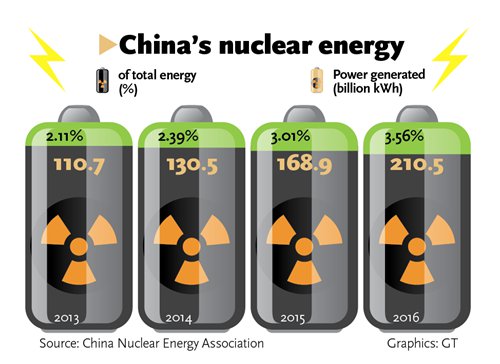
Projects to improve economy, reduce fossil fuel energy, pollution: experts
The establishment of inland nuclear power plants will not only boost local employment and ensure a steady power supply, but will also reduce the reliance on fossil fuel energy sources and the emissions of carbon dioxide and other major pollutants, experts noted.
The comments came after reports that the country is moving ahead with its plan to build nuclear power stations in inland areas, with pre-selected sites including Taohuajiang in Central China's Hunan Province, Xianning in Central China's Hubei Province and Pengze in East China's Jiangxi Province.
The sites have almost been confirmed and construction is expected to start during the 13th Five Year Plan period (2016-20), China Youth Daily reported Monday, citing Wang Yiren, vice director of the State Administration of Science, Technology and Industry for National Defense.
Establishing nuclear power plants in inland areas will ensure a stable supply of electricity and optimize energy structures by reducing the reliance on fossil fuel energy, Li Ning, the dean of the College of Energy at Xiamen University, told the Global Times on Monday.
"For example, Hunan is a province with a large electricity demand, but has a shortage of hydropower and is far away from coal mines. In this regard, building a nuclear power plant here will alleviate pressure on resources and transportation volume," he explained.
China had 35 nuclear power units in commercial operation by the end of 2016, with a combined installed capacity of 33,632 megawatts, according to a report released by the China Nuclear Energy Association (CNEA) on February 13.
However, China's electricity generated by nuclear power represents only 3 percent of the country's total, much lower than the global average of 11 percent, according to the China Youth Daily article.
The report noted that China's nuclear power capacity would reach 58,000 megawatts by 2020 and the capacity of plants under construction would be 30,000 megawatts.
"If the plan is implemented, thousands of jobs are expected to be created during about five-year construction period. And some 1,000 to 2,000 jobs will be produced by one nuclear power plant. Besides, local factories will be the first in line for electricity generated by nuclear power plants, which will meet their growing demand," Li said.
The investment returns from nuclear power stations is substantial, according to Wang Dezhong, a professor specializing in nuclear-related technology at the School of Mechanical Engineering of Shanghai Jiao Tong University.
The investment of a third-generation million-kilowatt nuclear power unit is more than 10 billion yuan, but its production value is around 10 million yuan per day for a 60-year operation, he told the Global Times on Monday.
In addition to economic benefits, building nuclear power stations in inland areas is also conducive to energy structure optimization, environmental protection and measures to embrace climate change, experts noted.
For a million-kilowatt electricity generating unit, 300 tons of fuel are needed a year by a coal-fired electricity-generating model, 15 times more than nuclear, Li said.
In 2016, electricity generated by nuclear energy was 210.5 billion kilowatt hours, the equivalent of 65.68 million tons of standard coal used in coal-fired electricity-generating plants, according to the CNEA report.
Safety standards
Building nuclear power plants inland is essentially the same as building them in coastal areas, and security can be ensured if workers comply with security codes and standards, according to Wang Yiren in the China Youth Daily report.
Wang from Shanghai Jiao Tong University said that building an inland nuclear power station is technically feasible. An inland nuclear power station will use cyclical water cooling towers, instead of draining away or pumping water from rivers, he said.
About 60 percent of nuclear power stations in the world are built in inland areas, Li said, noting that safety issues are unlikely to occur if they are built in non-seismic regions.
Though the safety of third-generation nuclear power plants has been greatly improved, compared with those in the 1970s, some issues need to be solved for the establishment of inland nuclear power stations, according to Li.
"The location of the nuclear power plants should be isolated from densely populated areas. Sufficient cooling water is needed. Besides, there should be large electricity demand as well as acceptance from local authorities and residents," he said.


















































